$84
VITAMIN D (ALSO KNOWN AS VITAMIN D3 AND CHOLECALCIFEROL)
Vitamin D can be synthesized in the skin through a process that is dependent on sun exposure to ultraviolet (UV) radiation. Vitamin D is converted by the body to 25-hydroxyvitamin, which is measured in blood tests to determine vitamin D status, and then to 1,25-dihydroxyvitamin D, which is the biologically active form. Vitamin D circulates as a hormone in the blood, and has a major role in regulating calcium, magnesium, and phosphate, which have major impact on bone. In addition, vitamin D has several other effects, including on cell growth, proliferation, and differentiation, calcium signaling, brain development, neurotrophic and neuroprotective actions, neurotransmission, synaptic plasticity, neuromuscular and immune functions, reduction of inflammation, and regulation of gene expression. Deficiency of vitamin D is caused by inadequate sun exposure in conjunction with inadequate dietary intake. Deficiency is common even among individuals with light skin tones with the modern custom of extensive skin coverage by clothes and sunscreens, and increasingly sedentary, indoor lifestyles. Vitamin D is present in appreciable quantities in only a few foods, and supplementation is increasingly recommended. Vitamin D deficiency typically results in impaired bone mineralization, which leads to bone fractures and bone-softening diseases including osteomalacia in adults, and rickets in children. Thus, vitamin D is often used to treat bone-related conditions, although it is often recommended for many other conditions beyond the skeleton.
Multiple studies have explored the relationship between vitamin D and autism. Fortified foods provide most of the vitamin D in the American diet, but many of the highest sources, such as milk, are often not part of the diet in individuals with ASD. Several studies have documented that vitamin D deficiency is common among children with ASD, including 87% with 25-hydroxyvitamin D levels below 30 ng/ml (a threshold of which lower levels are considered to be inadequate by many) in one such study. A few clinical trials have demonstrated clinical improvement in children with ASD following vitamin D supplementation, including in 81% in one study, with better outcomes with treatment blood levels over 40 ng/ml. A randomized controlled trial in 109 children with ASD revealed significant improvement in the group receiving very-high-dose vitamin D. Overall, the studies performed to date, and the lack of toxicity to usual dosing regiments, have convinced experts that vitamin D is important in children with ASD. While sun exposure is an excellent way to boast vitamin D levels, practical concerns in the ASD population, and fear of cancer, have led many to recommend supplementation and the monitoring of this therapy by blood levels. Vitamin D toxicity is very rare, even in studies using extremely high doses by injection, although levels of 25-hydroxyvitamin D above 50 or 60 ng/ml may be too high.
 Vitamin D in Spectrum Needs
Vitamin D in Spectrum Needs
Vitamin D is added in order to provide a wide basis of nutrition, especially given the preliminary data regarding its use as a food supplement in ASD. As Spectrum Needs is designed to be used by a wide variety of individuals regardless of supplement status, the vitamin D dose in this product is high, but not among the very high doses advocated by some experts. Side effects and/or levels > 50 ng/ml are unexpected with the dose of vitamin D used in Spectrum Needs. You may wish to speak to your physician regarding blood testing and potential additional vitamin D supplementation beyond that provided by Spectrum Needs.
While the term vitamin D refers to a group of fat-soluble steroids, the most important member of this group, and the one present in supplements, is vitamin D3 (also known as cholecalciferol), which is referred to herein as simply “vitamin D”. Vitamin D can be synthesized in the skin from cholesterol through a process that is dependent on sun exposure to ultraviolet (UV) B radiation. Vitamin D is converted in the liver to 25-hydroxyvitamin D (also known as 25(OH)D), which is the compound measured in blood to determine a person’s vitamin D status. 25-OH-vitamin D is further converted by the kidneys to form 1,25-dihydroxyvitamin D, which is the biologically active form of vitamin D.
1,25-dihydroxyvitamin D (also known as calcitriol) circulates as a hormone in the blood, and has a major role in promoting the healthy growth and remodeling of bone. In particular, calcitriol increases intestinal absorption of calcium, magnesium, and phosphate, as well as being required for bone growth and remodeling by bone cells (osteoblasts and osteoclasts). Calcitriol also has several other effects, including on cell growth, proliferation, and differentiation, calcium signaling, brain development, neurotrophic and neuroprotective actions, neurotransmission, synaptic plasticity, neuromuscular activity, immune function, reduction of inflammation, and regulation of gene expression. Vitamin D regulates about 3% of all of the about 25,000 genes in humans, including in potential relationship to ASD, activating the TPH2 gene that synthesizes tryptophan in the brain (https://www.ncbi.nlm.nih.gov/pubmed/24558199).
Deficiency of vitamin D is caused by inadequate sun exposure in conjunction with inadequate dietary intake. Deficiency is increasingly common throughout the world. While often thought of as only a substantial issue in darker-skinned individuals, deficiency is common even among those the lightest skin tones with the modern custom of extensive skin coverage by clothes and sunscreens, and with increasingly sedentary, indoor lifestyles. As vitamin D is present in appreciable quantities in only a few foods, mostly oily fishes, supplementation is increasingly recommended. Of note, bowel disease can also predispose towards vitamin D deficiency by decreasing absorbance even when some supplementation is provided. Vitamin D deficiency typically results in impaired bone mineralization, which leads to bone fractures and bone-softening diseases including osteomalacia in adults, and rickets in children.
Multiple studies have explored the relationship between vitamin D and autism (reviewed in https://www.ncbi.nlm.nih.gov/pubmed/28217829). Per that review article, “(a)n increasing amount of evidence points to the possibility that gestational and early childhood vitamin D deficiency [25(OH)D < 40 ng/ml] cause some cases of autism.” Many different theories for how vitamin D deficiency might predispose towards ASD have been described, including roles of vitamin D in reducing inflammatory cytokines and boasting antioxidant capabilities, which are hypotheses that connect vitamin D with energy metabolism. Fortified foods provide most of the vitamin D in the American diet, but many of the highest sources, such as milk, are often not part of the diet in individuals with ASD. A meta-analysis combining 11 different studies found that a group of 870 children with ASD have significantly lower 25-OH-vitamin D blood levels than do 782 children without ASD (https://www.ncbi.nlm.nih.gov/pubmed/26514973). Furthermore, multiple studies have found that maternal vitamin D deficiency is a risk for ASD in the children. In one such study, lower first-trimester 25-hydroxyvitamin D blood levels in women was related to significantly increased risk of ASD, and of more severe manifestations of ASD, in the subsequent offspring. The risk of ASD in the lowest 25%, in terms of blood levels, was fourfold greater than in the highest 25% of the women (https://www.ncbi.nlm.nih.gov/pubmed/?term=27663117). The cause for vitamin D deficiency is likely both genetic and environmental. In one potential mechanism, new (de novo) mutations in vitamin D-related genes were more common in individuals with ASD versus in controls (https://www.ncbi.nlm.nih.gov/pubmed/28407358).
A few clinical trials have demonstrated clinical improvement in children with ASD following vitamin D supplementation (reviewed in https://www.ncbi.nlm.nih.gov/pubmed/28217829). In one such study on 122 ASD children, 87% had low 25-hydroxyvitamin D levels (< 30 ng/ml), and 57% revealed deficiency (< 20 ng/ml). Also, 25-hydroxyvitamin D were lower in patients with severe autism. In the children with low levels (<30 ng/ml) that completed 3 months of daily vitamin D supplementation, 80.72% (67/83) had “significantly improved outcome(s)”, including in measured “behavior, stereotypy, eye contact, and attention span”, “especially when the final (blood) level is more than 40 ng/ml” (https://www.ncbi.nlm.nih.gov/pubmed/25876214). A randomized controlled trial in 109 children with ASD revealed significant improvement in the group receiving vitamin D (https://www.ncbi.nlm.nih.gov/pubmed/?term=27868194). In that study, all of the children had a normal or borderline vitamin D status as those with 25-hydroxyvitamin D levels below 20 ng/ml were excluded for ethical reasons and treated with vitamin D. In addition, as in many of the studies, the dose of vitamin D provided was substantially higher than that in routine supplementation (300 IU/kg/day up to a maximum of 5000 IU/day).
Overall, the studied performed to date, and the lack of toxicity to usual dosing regiments, have convinced many experts that vitamin D is important in children in general, and particularly in those with ASD. While sun exposure is an excellent way to boast vitamin D levels, practical concerns in the ASD population, and fear of cancer, have led many to recommend supplementation and the monitoring of this therapy by blood levels.
Alpha-lipoic acid supplements have been used in Europe and elsewhere for certain types of nerve damage, especially that related to diabetes. Several studies have shown that ALA can improve insulin resistance. There is some data that long-term use of alpha lipoic acid might help with oxidative damage related to aging (including its use in skin creams). Other uses include in Amanita mushroom poisoning, glaucoma, retinal disorders, cataracts, kidney disease, migraines, memory loss, chronic fatigue syndrome, cancer, liver disease, cardiovascular diseases, HIV/AIDS, Lyme disease, and obesity.
Vitamin D is fat soluble, yet toxicity appears to be rare, even in studies using extremely high doses such as 150,000 IU/month by intramuscular injection. Some sources suggest that blood levels of 25-hydroxyvitamin D above 50 or 60 ng/ml may be too high, and if present recommend reducing the amount of supplement provided (Institute of Medicine, Food and Nutrition Board. Dietary Reference Intakes for Calcium and Vitamin D. Washington, DC: National Academy Press, 2010; https://ods.od.nih.gov/factsheets/VitaminD-HealthProfessional). Side effects are rare at usual doses used in supplementation.
Blood testing of 25-hydroxyvitamin D is the best indicator of vitamin D status. Testing can be used to diagnosis deficiency as well as to monitor therapy, and is recommended by many experts for all individuals with ASD.
Spectrum Needs is designed to be used by a wide variety of individuals with ASD, many of which are already on vitamin D supplementation and/or with blood levels that already may have been determined to be adequate. In addition, there is a lot of controversy about what 25-hydroxyvitamin D levels are ideal, with the Institute of Medicine stating levels above 20 ng/ml are adequate (Institute of Medicine, Food and Nutrition Board. Dietary Reference Intakes for Calcium and Vitamin D. Washington, DC: National Academy Press, 2010), most laboratories listing 30 ng/ml as “normal”, and some studies in ASD recommending levels above 40 ng/ml. Achieving the latter level may require doses of which many physicians are uncomfortable. Thus, the vitamin D dose in this product (600 IU for children of 44-88 lbs, 900 IU in adults) is high, but not among the very high doses advocated by some experts. You may wish to speak to your physician regarding blood testing and potential additional vitamin D supplementation beyond that provided by Spectrum Needs.
How and why Vitamin D is used in Spectrum Needs
Order SpectrumNeeds Today
Formulations

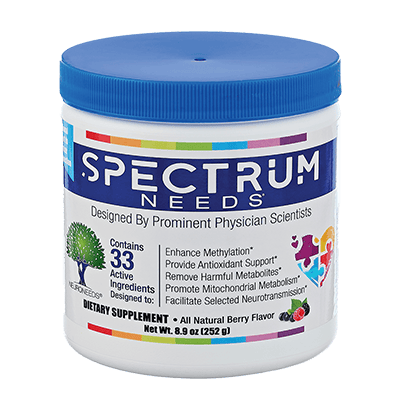
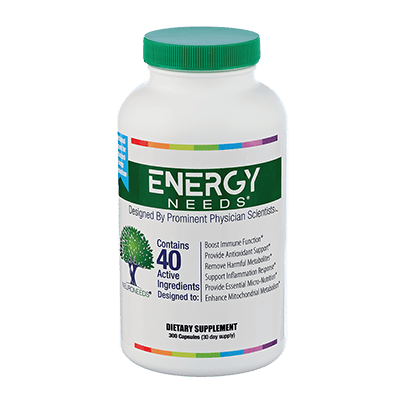
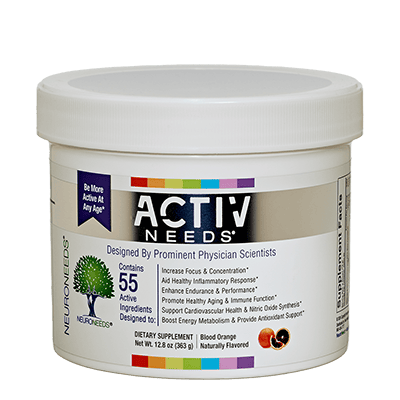
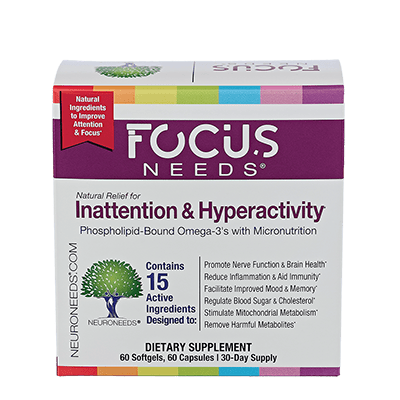
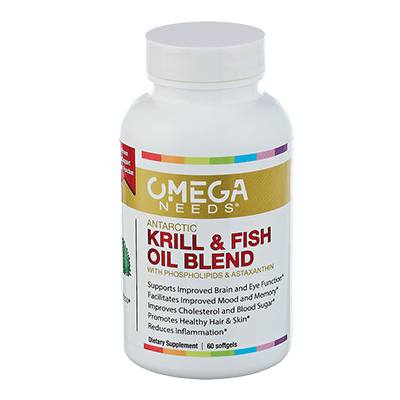
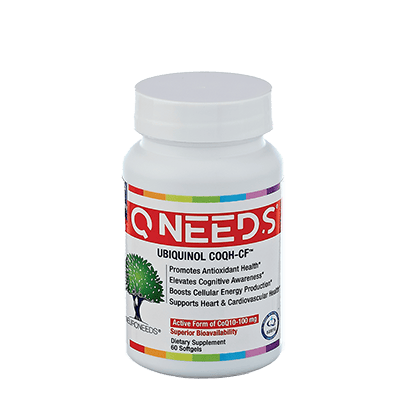
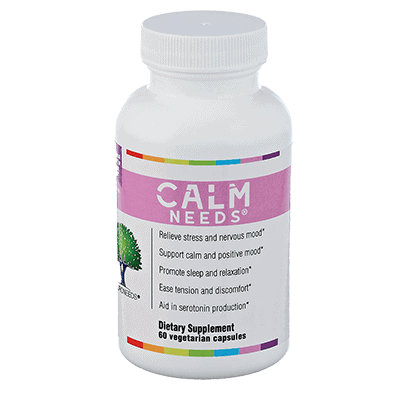
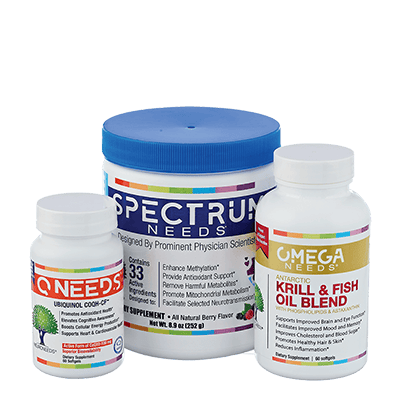
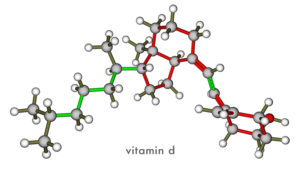 Vitamin D in Spectrum Needs
Vitamin D in Spectrum Needs
